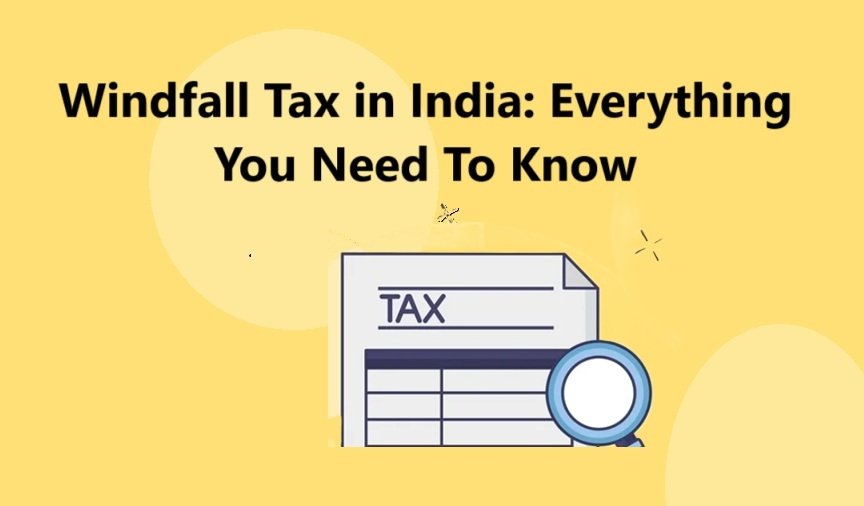
Windfall Tax in India: Everything You Need To Know
Introduction
A windfall tax is a special tax imposed by governments on companies that experience unexpected and extraordinary profits, often due to favorable external circumstances rather than their own business strategies. In recent years, the concept of windfall taxes has gained prominence globally, including in India. This article delves into the nuances of windfall tax in India, explaining its purpose, implementation, impact, and challenges.
What is Windfall Tax?
The term “windfall” refers to a sudden or unexpected gain or profit. A windfall tax is designed to capture a portion of these unexpected gains and direct them towards public welfare or other government priorities. These taxes are usually levied on specific sectors that benefit disproportionately from external factors such as global price fluctuations, geopolitical developments, or natural resource discoveries.
Why Do Governments Impose Windfall Taxes?
Governments impose windfall taxes for several reasons:
- Redistribution of Wealth: Extraordinary profits earned by companies often result from external factors. Governments view windfall taxes as a means to redistribute wealth and address economic inequalities.
- Revenue Generation: Windfall taxes provide a source of additional revenue for governments, especially during economic crises or periods of high fiscal deficits.
- Economic Stabilization: These taxes can help moderate excessive profits in certain industries, preventing market distortions and ensuring fair competition.
The Introduction of Windfall Tax in India
India introduced windfall taxes in 2022, primarily targeting the oil and gas sector. This move came against the backdrop of surging global crude oil prices due to the Russia-Ukraine conflict, which led to massive gains for oil companies exporting petroleum products. The government imposed the tax to capture a share of these unexpected profits and use the proceeds to support domestic welfare initiatives.
Key Features of Windfall Tax in India
- Scope: The windfall tax in India initially targeted crude oil producers and exporters of petroleum products like diesel and aviation turbine fuel.
- Rate: The tax rates are reviewed and adjusted periodically based on international price trends. For instance, in the initial phase, the tax on crude oil production was set at a fixed amount per barrel.
- Implementation: The tax was implemented through a special notification under the Finance Act, allowing flexibility in revising rates as per changing market conditions.
- Duration: Windfall taxes are generally temporary and are removed once the extraordinary circumstances leading to the windfall profits subside.
Impact of Windfall Tax
On Companies
- Reduced Margins: Companies subject to windfall tax experienced a decline in profit margins, impacting their stock valuations and investor sentiment.
- Operational Adjustments: To offset the impact of the tax, some companies resorted to operational adjustments, including cost-cutting measures and strategic realignments.
On the Economy
- Increased Revenue: The government’s revenue from windfall tax bolstered public finances, enabling increased spending on welfare and infrastructure projects.
- Market Dynamics: The imposition of the tax led to a recalibration of market dynamics, particularly in the oil and gas sector.
On Consumers
- Price Stability: By capturing excess profits, the government aimed to stabilize prices and shield consumers from the adverse effects of global price volatility.
Challenges and Criticisms
- Predictability and Fairness: Companies argue that windfall taxes undermine predictability in taxation and penalize legitimate business success.
- Investor Confidence: Frequent changes in tax rates and policies can deter foreign and domestic investment.
- Administrative Complexity: Implementing and monitoring windfall taxes requires significant administrative effort and coordination.
- Sector-Specific Focus: Critics highlight that focusing on specific sectors may ignore other industries that also benefit from external factors.
How Does a Windfall Tax Work?
A windfall tax is a temporary charge introduced by governments on certain industries that witness a sharp rise in profits due to unforeseen events. The purpose of this tax is to capture a portion of these extraordinary gains and redirect the funds towards other priorities.
Unlike standard corporate taxes, windfall taxes are not based on routine business performance. They specifically target sudden and temporary profit surges. These unexpected gains often arise from external factors such as wars, natural disasters, or abrupt changes in global trade agreements that disrupt supply chains and lead to price spikes in particular commodities. For example, the surge in oil prices during the Russia-Ukraine conflict in 2022 serves as a notable case.
Windfall taxes come with both benefits and drawbacks:
- Advantages: They provide additional revenue for governments, which can be allocated to social welfare programs, infrastructure projects, or reducing budget deficits.
- Disadvantages: Businesses may contend that windfall taxes deter investment and hinder long-term growth. Moreover, they can create uncertainty within the affected industries.
Windfall Tax Revisions (Between 2022-2024)
| Date | Revisions |
| July 2022 | Windfall tax proposed (effective September 1, 2022)Initial rate for domestic crude oil: ₹23,250 per tonne |
| August 2022 | Revised tax structure due to declining oil pricesLower tax on domestic crude oilIncreased tax on diesel exports (₹6 to ₹12 per litre) and gasoline exports (₹13 per litre)Revised export cess on aviation turbine fuel (ATF) |
| April 2023 | Windfall tax on crude oil was abolished initiallyReintroduced and raised to ₹6,400 per tonne |
| May 2024 | Reduced windfall tax on domestically produced crude oil to ₹5,700 per tonne (from ₹8,400 per tonne) |
| June 2024 | Further reduced windfall tax on domestic crude oil to ₹5,200 per tonne (from ₹5,700 per tonne)Export duty on petrol, diesel, and ATF remained unchanged (nil) |
Global Perspective
India is not alone in imposing windfall taxes. Countries like the United Kingdom and Italy have also introduced similar measures, primarily targeting energy companies benefiting from global price surges. While the specifics vary, the underlying rationale remains consistent: capturing extraordinary profits for public benefit.
The Way Forward
To ensure the effective implementation of windfall taxes, the government needs to:
- Establish Clear Guidelines: Clear criteria for identifying and taxing windfall profits can improve transparency and predictability.
- Engage Stakeholders: Engaging with industry stakeholders can help address concerns and foster collaboration.
- Monitor Impact: Regular assessment of the tax’s economic and social impact can inform future policy decisions.
- Focus on Equity: Striking a balance between revenue generation and economic equity is crucial to avoid unintended consequences.
Conclusion
Windfall tax is a powerful tool for governments to capture unexpected gains and direct them toward public welfare. In India, the introduction of this tax has provided much-needed revenue during challenging times while sparking debates on fairness and economic impact. As the global economic landscape continues to evolve, the role of windfall taxes is likely to remain a significant aspect of fiscal policy.






